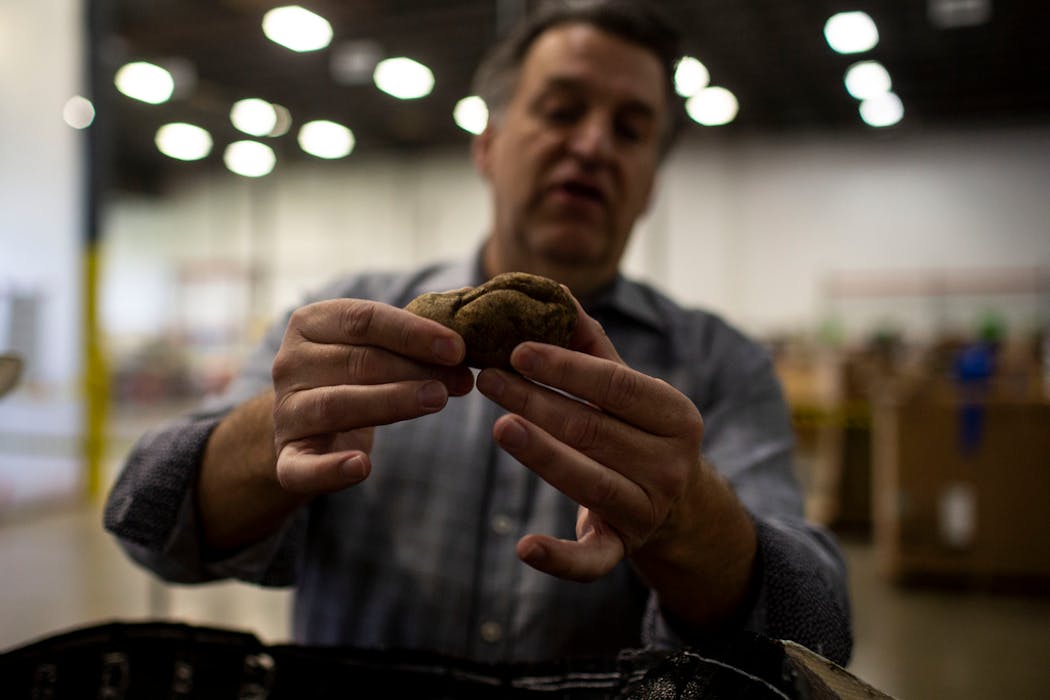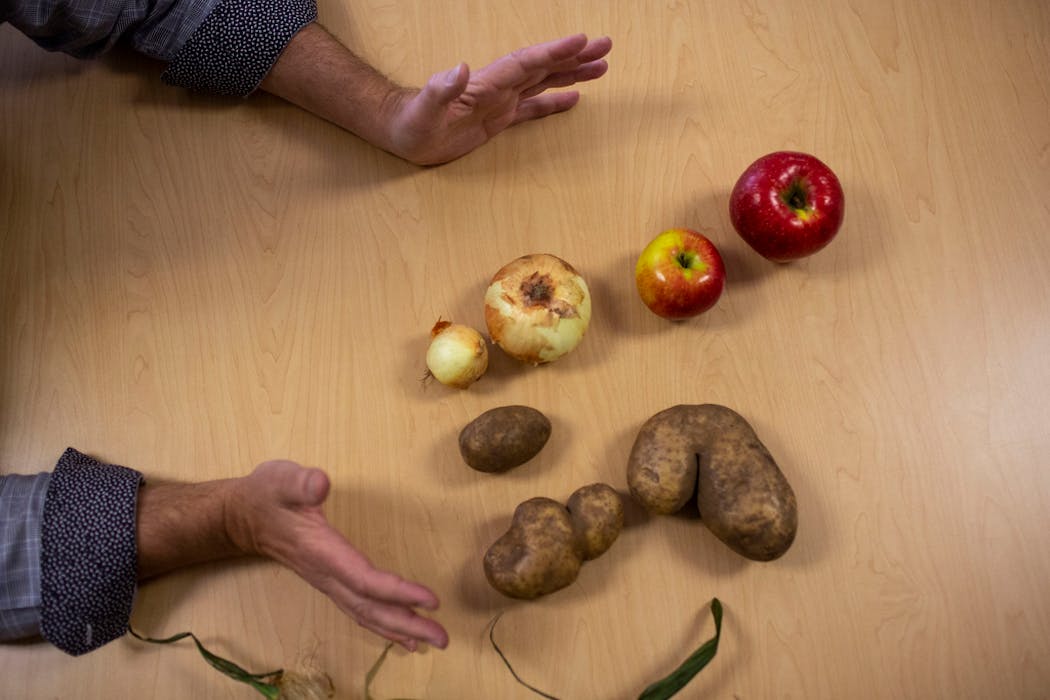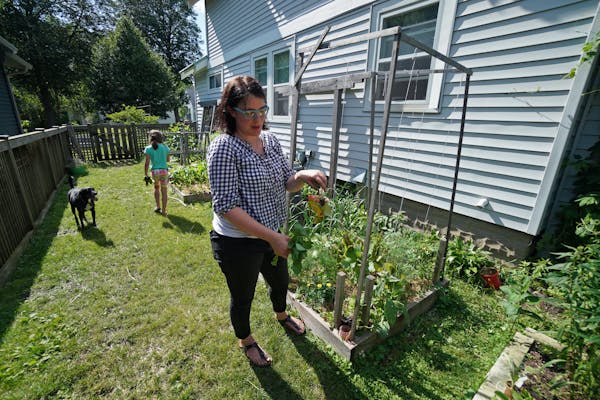Kaitlin Groeneweg walks to the grocery store instead of driving so she'll buy less, knowing she must carry her shopping bags. Whenever it's an option, she chooses to purchase single pieces of produce instead of bundles. She joined a CSA, but quit when she struggled to keep up with the amount of fruits and vegetables she was getting in her boxes, even with only a half-share.
To the measures the Minneapolis resident has taken to reduce her contributions to food waste, she can now add welcoming so-called "ugly" produce into her kitchen.
Groeneweg recently joined Imperfect Produce, a weekly subscription service that delivers boxes of scuffed, misshapen or surplus fruits and vegetables to customers' homes. The national company just expanded to the Twin Cities this past spring.
The service is one part of a burgeoning movement to create a path for less desirable produce into people's diets, and away from compost piles.
Almost half the fruits, vegetables, roots and tubers grown globally go uneaten, according to the United Nations Food and Agriculture Organization. Some of the losses occur in the fields. But once harvested, produce undergoes a strict sorting process based on what most consumers are willing to spend their money on.
"It comes from the abundance we have in this country and have had for the last 50 years or so," said Ben Simon, Imperfect Produce's co-founder and CEO. "When you have so much, you stop valuing food the same way as a precious resource that should never go to waste."
Of the produce that makes it to a supermarket, the displays at store entrances favor a perfectly round and red apple with movie-star good looks over an oddball heart-shaped potato or a carrot that resembles arthritic knuckles.
"Many consumers these days don't have a tie back to a farming community," said Jennifer van de Ligt, director of the Integrated Food Systems Leadership Program at the University of Minnesota. "They've only ever seen perfect fruit, and the opinion is out there that if it's not perfect it doesn't taste good, it's not as healthy and it's not going to last as long. And none of that is really true."
Awareness increases
Attitudes are slowly shifting, thanks to programs such as Imperfect Produce. So, too, with food rescue programs such as the one at Second Harvest Heartland, which takes donations of unusual-looking or excess produce from farmers and gets it to people who are hungry. Education from farms, food co-ops and even larger grocers has also had an effect.
Hy-Vee supermarkets, for example, sell a line of Misfits, which a spokesperson called "cosmetically challenged" produce, bundled together at a 30% discount.
The Twin Cities area's vast network of co-ops brings consumers closer to pesticide- and preservative-free produce that might show even more imperfections — and to the farmers growing them.
"There's still this stigma, but I think a lot of people who shop at co-ops understand the farmer mind-set, and that might be one of the reasons they're shopping with us," said Chelsea Korth, sales manager for Twin Cities Co-op Partners.
Imperfect Produce prices its produce about a third less than a typical supermarket price. It's able to do that because it buys food from farmers at a heavy discount — food that would otherwise go to waste, or at the very least, be turned into animal feed.
Each week, customers can customize a box depending on what's available and how much they need. Groeneweg said she spends about $20 per week for the chance to cook with a flattened squash or an extra-small bell pepper.
Imperfect Produce celebrates what its CEO calls "the wonkiest" fruits and vegetables or "VIPs — very imperfect produce." The company puts googly eyes on the weirdest pieces — such as a two-legged strawberry, a hunched-over butternut squash and an eggplant with a nose — and posts them to Instagram. It's the body-positive movement of produce.
Most of what customers receive, however, does look perfect. Groeneweg said she hasn't been able to detect anything wrong with her fruits and vegetables. That's because much of what is boxed up and sent out isn't misshapen at all. It might be a fraction too small or too big to be considered standard. Or it's just surplus.
"The fact that so much of it looks so normal is really a testament to the cult of perfection that we have," said Simon of Imperfect Produce.
Farmers are trying to minimize the amount they grow that never makes it into shopping carts.
Wescott Orchard and Agri Products, the Elgin, Minn.-based grower, distributor and processor of apples, aims to control how an apple "finishes" by estimating how many blossoms a tree can handle before it gets too crowded to form a perfectly red and sun-dappled piece of fruit, in one of five sizes that consumers find acceptable (out of the 11 or so sizes apples tend to come in).
"Retail doesn't want that low-color apple," said Don Roper, vice president of Wescott Agri Products. "They want that high color for the perception of premium fruit they're going to sell their customer. That's always been the battle."
Even by managing the trees, some apples don't make the cut. Roper estimated that four boxes of apples are turned away for every 20 boxes picked — a 20% loss. Some of those unsold apples get turned into cider, while some become pig feed.
And some of those apples — big as a grapefruit or small as a tangerine — are among the millions of pounds of food donated to Second Harvest Heartland, Minnesota's largest food bank.
"We don't call it ugly fruit. We just call it fruit and vegetables," said Bob Branham, director of produce strategy.
Other names for what the food bank receives is Grade B, "out-of-spec" or secondary produce. Second Harvest's new 250,000-square-foot warehouse in Brooklyn Park is filled with it.
Plenty of produce
Pallets are lined with huge sacks of "twin" Yukon potatoes, oranges with scuff marks and cabbages whose outer leaves have withered but whose interiors are still fresh. Each week 40,000 pounds of "funky" potatoes come through the warehouse, mostly from Minnesota and Wisconsin farmers, Branham said. Staffers check random pieces for spoilage, peel back brown leaves if needed, and get the otherwise edible fresh fruits and vegetables to hungry families.
For recipients, there's nothing ugly about their next meal.
But with for-profit outfits such as Imperfect Produce paying farmers for their Grade B fruits and vegetables, could donations dry up?
"There's anxiety from some people that they'll take from our donors and they'll create scarcity in the marketplace for the secondary market," Branham said. "But my personal feeling is it would take a transition, a significant shift in consumer behavior, to take all of the ugly produce, as it were, out of the marketplace."
Meanwhile, consumers' learned affinity for the most beautiful beets and the top bananas isn't exactly going away.
"People buying ugly produce is not going to solve the food waste issue," said the U's van de Ligt.
But it's a start.
Her No. 1 tip to consumers who want to cut back on their waste?
Whether buying ugly produce or not, she said, "Just make sure you're going to use it."
Sharyn Jackson • 612-673-4853 • @SharynJackson
John Adams' Nativity oratorio 'El Nino' gets colorful staging at the Met
Taylor Swift's 'The Tortured Poets Department' is here. Is it poetry? This is what experts say
Finding an apartment may be easier for California pet owners under new legislation
4/20 grew from humble roots to marijuana's high holiday




